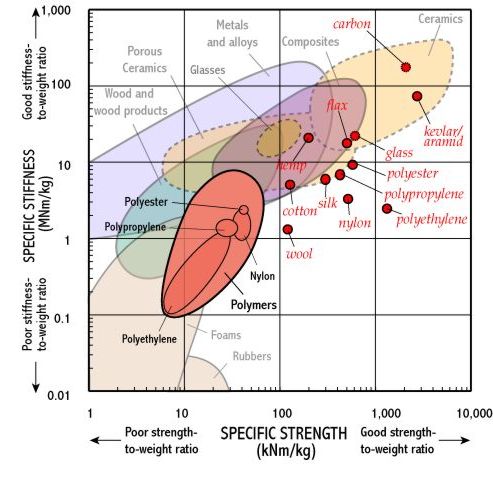![]() Download this document in PDF
format.
Download this document in PDF
format.
Historically, most designs have been made of leather or other natural materials. Current technologies allow synthetic polymers such as polypropylene to replace natural materials - these can easily be moulded or woven, and made in exotic colours or even translucent. Interesting, semi-rigid shapes can be moulded from the class of polymers known as elastomers (rubbers); polychloroprene (also known as neoprene) is one of these materials used in recent designs.
A school book bag must support more weight than a hand bag and provide adequate wear resistance to survive the school environ-ment for at least a couple of years. The most common materials chosen for this design are natural or polymer fabrics: canvas (usually cotton-based), nylon and polyvinylchloride (PVC) are examples.
For mountaineering gear, the material and product must perform to high standards with special consideration for the weight of the product, its ability to withstand damage (such as scraping on rocks) and its performance in poor weather. Mountaineering backpacks have evolved from canvas to nylon to PTFE. "Goretex" is a PTFE-based laminated fabric used for wet-weather gear because the 'holes' between the fibres are too small to allow water in, but coarse enough to allow water vapour out.
RequirementsEach type of bag involves a different set of design requirements. All bags must be strong enough to carry the required load. However, the bag must provide this strength subject to other, less easily quantified, design requirements - see the table. Fabrics give a product good strength at low weight, while being very flexible and having good aesthetic qualities for designers to exploit. |
|
Joining of fabricsThe most common joining method used for fabrics is stitching. Stitching is a very versatile and fast process, though selecting the thread, fabric layup and stitching the pattern are skilled design processes. Stitching works with almost every fabric and can also join fabrics round difficult curved seams (such as for putting the arms onto a jacket). Many joining processes are limited to flat, nearly straight joints, and some will only work with specific fabrics (depending on the polymers used in the fabric). |
|

A fabric is a "structured material", usually made as a flat, flexible sheet, by weaving or knitting fibres in bundles - some processes simply tangle the fibres up and the fabric holds together by friction between the fibres. Many fabrics are made as multi-layer composites, with polymer films covering the weave on both sides (this could be to give protection to the fibres, to provide waterproofing, or to change the appearance of the fabric). The fibres can be aligned or random, and are made of natural materials like silk, cotton or wool, or of synthetic materials like nylon, polyethylene (PE), carbon, glass or aramid (known under the trade name Kevlar).
For high performance fabrics, we require strength and reasonable stiffness at low weight. The strength and stiffness of a fabric depends on the type of fibre used, but is also strongly affected by the type of weaving used (which changes the waviness and amount of friction between the fibres). Many fabrics are also composites of a strong fibre weave laminated with weaker polymer coatings. The fibres are critical however, so it is useful to plot their specific strength and specific stiffness on a selection chart - this allows comparison of natural and synthetic fibres, and also comparison of synthetic fibres with the same polymers in bulk form.
The chart shows that many fibres have excellent specific properties - but of course these can only be exploited by building the fibres into a structured material like a rope or a fabric. The material bubbles in red show long-fibre properties; the other materials and material classes show bulk properties i.e. those you would expect if the material is not drawn into fibres. The strength for the bulk ceramics shown on the chart is compressive strength - the tensile strength is typically only 10% of this value; for the other materials the strength is similar in compression and tension; the strength for all fibres is for loading in tension.
|
|
|
Many fabric properties - particularly strength, stiffness and tear resistance - are directional, i.e. they depend upon the direction of loading compared to the orientation of the fabric. Most woven fabrics have two stiff/strong directions at right angles to each other, parallel to the fibres, with much lower properties in between ("on the bias"). This "anisotropic" structure gives these materials their unique properties.
|